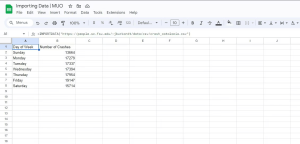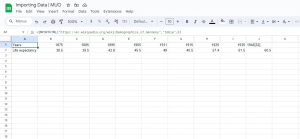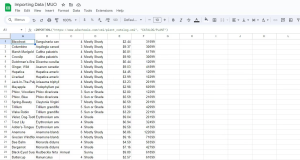Productivity
Effortless Data Import: 4 Ways to Get Data from Websites into Google Sheets
Introduction: Get Data from Websites into Google Sheets
In today’s data-driven world, access to information is paramount. Whether you’re a business analyst, a researcher, or someone who relies on data for informed decision-making, the ability to efficiently import online data into your Google Sheets is a skill worth mastering. Gone are the days of manual copy-pasting, which not only consumes time but often results in formatting woes and errors. In this article, we’ll explore four powerful methods to seamlessly import data from websites into Google Sheets. Whether you’re dealing with CSV files, tables, lists, XML, or HTML data, these techniques will revolutionize your data-handling workflow. Say farewell to tedious data entry and embrace the era of effortless data import.
1. IMPORTDATA: The Quick Solution for Online Files
Suitable For: CSV and TSV files
The IMPORTDATA function is your go-to tool for importing data from online CSV or TSV files with minimal effort. Its simplicity and ease of use make it the perfect choice for straightforward data imports.
The formula format is as follows: =IMPORTDATA(URL, delimiter, locale)
- URL: The web address of the file you want to import.
- Delimiter (optional): The character used to parse data in the file.
- Locale (optional): The specific locale for formatting, often left blank for automatic detection.
For example, to fetch data from a CSV file, you can use a formula like this:

Image by https://www.makeuseof.com/
=IMPORTDATA("https://example.com/datafile.csv")
Note: While IMPORTDATA is excellent for CSV and TSV files, avoid using it for web pages as it may not return the expected data.
2. IMPORTHTML: Your Table and List Ally
Suitable For: Tables and lists on web pages
If you need to import data tables or lists directly from web pages without dealing with CSV files, IMPORTHTML is your best friend. This function simplifies the process and allows you to focus on the data itself.
The formula format is: =IMPORTHTML(URL, query_type, index)
- URL: The web address containing the table or list.
- Query_type: Specify either “table” or “list” based on what you want to import.
- Index: The position of the table or list on the web page.
For instance, to import a specific table from a Wikipedia article, you can use a formula like this:

Image by https://www.makeuseof.com/
=IMPORTHTML("https://en.wikipedia.org/wiki/Demographics_of_Germany", "table", 8)
IMPORTHTML fetches the data from the specified URL and outputs the table you specify.
3. IMPORTXML: The XML and HTML Data Fetcher
Suitable For: XML and HTML pages
When you need to extract data from XML or HTML pages, the IMPORTXML function comes to the rescue. It allows you to fetch data using XPath queries, making it a powerful tool for structured data extraction.
The formula format is: =IMPORTXML(URL, xpath_query)
- URL: The web address containing the XML or HTML data.
- Xpath_query: The XPath query that identifies the nodes you want to import.
For example, to extract data from an XML file containing plant information, you can use this formula:

Image by https://www.makeuseof.com/
=IMPORTXML("https://www.w3schools.com/xml/plant_catalog.xml", "CATALOG/PLANT")
IMPORTXML retrieves the data based on your XPath query. It’s important to have a basic understanding of XML and XPath to use this function effectively.
4. Use Google Sheets Add-Ons for Advanced Import
Suitable For: Various online sources that require authentication
In addition to Google Sheets’ built-in functions, there’s a world of possibilities through third-party add-ons. These add-ons simplify data imports and grant access to resources that require authentication.
Here are some notable add-ons for advanced data import in Google Sheets:

Image by https://www.makeuseof.com/
- Coefficient: A user-friendly add-on for fetching data from websites without coding. Supports various business systems.
- Coupler.io: Simplifies data imports from multiple sources and allows scheduled updates.
- Awesome Table: Not just for importing but also customizing and transforming data for enhanced analysis.
These add-ons offer convenience, security, and additional features like data transformation and automatic updates, enhancing your data import workflow.
Table:
| Method | Suitable For | Description |
|---|---|---|
| IMPORTDATA | CSV and TSV files | Simple data imports from online files with minimal setup. |
| IMPORTHTML | Tables and lists | Import tables/lists from web pages without needing CSV files. |
| IMPORTXML | XML and HTML pages | Fetch data from XML/HTML pages using XPath queries. |
| Add-Ons | Various online sources | Third-party add-ons like Coefficient, Coupler.io, and Awesome Table extend data import capabilities. |
Conclusion:
Efficiency and accuracy are the cornerstones of effective data handling, and when it comes to importing data into Google Sheets, these four methods have you covered. From the straightforward IMPORTDATA function for online files to the versatile IMPORTHTML and data-extraction prowess of IMPORTXML, you now have a toolkit to fetch data effortlessly. But don’t stop there—consider exploring third-party add-ons like Coefficient, Coupler.io, and Awesome Table to further streamline your data import processes. With these tools at your disposal, you’ll not only save time but also elevate the quality of your data analysis. So, bid farewell to the old ways of data entry and embark on a journey of efficient, accurate, and hassle-free data imports in Google Sheets.
Business
Top ERP Providers With the Highest Customer Service Ratings

Introduction
Choosing the right ERP software company is about more than features and price – it’s about people, support, and long-term partnership. In this post you’ll get a human-friendly, step-by-step guide to understanding which ERP providers get the highest customer service ratings, what makes support great, and how to evaluate vendors for your business (whether you need ERP systems for manufacturing, cloud based ERP, or bespoke ERP solutions). At the end, we’ll explain why many businesses trust The Presence360 as their ERP partner.
Why customer service matters for an ERP system
An ERP system touches finance, HR, inventory, manufacturing and more. When something breaks, slow support means lost hours, missed orders, and frustrated teams. High-rated ERP software providers deliver:
- Fast, knowledgeable technical support
- Clear implementation guidance and training
- Proactive account management and regular updates
- Transparent SLAs and escalation paths
Great support increases ROI, shortens time-to-value, and builds trust – especially for complex ERP solutions like ERP systems for manufacturing.
What customers rate most highly in ERP vendors
Across reviews and surveys, customers frequently praise vendors for:
- Responsiveness quick ticket resolution and live support.
- Expertise consultants who understand industry workflows (e.g., manufacturing BOMs, shop floor control).
- Onboarding & training usable documentation, hands-on sessions, and role-based training.
- Customization support helping tailor the ERP without breaking upgrades.
- Cloud reliability stable uptime, automated backups, and security.
- Transparent pricing & honest communication.
If a vendor nails the above, they tend to receive top customer service ratings.
Top ERP Providers with Exceptional Customer Service
1. SAP
SAP is one of the most widely used ERP providers globally. Known for its robust features, SAP also excels in customer support.
- Support Channels: SAP offers 24/7 customer support, online chat, and dedicated account managers.
- Training & Resources: SAP provides extensive documentation, tutorials, and learning hubs for staff training.
- Customization Assistance: SAP’s support team helps businesses implement tailored solutions to fit specific industry needs.
- Why It Stands Out: SAP’s customer service ensures that large enterprises can resolve complex ERP issues efficiently.
2. Oracle NetSuite
Oracle NetSuite is a cloud-based ERP solution praised for its user-friendly interface and excellent customer service.
- Support Channels: Customers can access email, phone, and live chat support along with a knowledge base.
- Implementation Support: NetSuite offers professional services to help businesses set up and optimize their systems.
- Ongoing Assistance: Dedicated account managers guide companies through updates and feature integrations.
- Why It Stands Out: NetSuite’s focus on cloud-based support ensures flexibility and fast resolution times.
3. Microsoft Dynamics 365
Microsoft Dynamics 365 combines CRM and ERP capabilities with top-tier customer support.
- Support Channels: Microsoft offers phone support, online help portals, and community forums.
- Training & Documentation: Extensive tutorials, webinars, and guides are available for new and existing users.
- Customization Help: Microsoft’s certified partners assist in adapting the platform to business-specific needs.
- Why It Stands Out: Businesses benefit from Microsoft’s extensive network of support professionals and partners.
4. Odoo
Odoo is an open-source ERP provider that has rapidly grown in popularity due to its affordability and reliable support.
- Support Channels: Offers ticket-based support, email assistance, and a vibrant community forum.
- Customization Guidance: Odoo provides consulting services for module customization and integrations.
- Training Programs: Comprehensive webinars and documentation help businesses use the platform effectively.
- Why It Stands Out: Odoo combines accessible customer service with flexible solutions suitable for small to mid-sized businesses.
5. Infor
Infor provides industry-specific ERP solutions with a strong reputation for customer service.
- Support Channels: Includes phone support, online resources, and dedicated support portals.
- Industry Expertise: Infor’s consultants understand specific industries, offering tailored advice and troubleshooting.
- Ongoing Assistance: Regular check-ins and proactive support help prevent operational issues.
- Why It Stands Out: Infor’s customer service is highly rated because of its focus on industry-specific solutions and rapid problem resolution.
Step-by-step: How to identify ERP providers with the best customer service
Step 1: Start with verified reviews and case studies
Look for long-form case studies and verified user reviews that describe real support experiences. Pay attention to stories about implementations and post-launch support.
Step 2: Ask for support KPIs and SLAs
Request average response times, escalation procedures, and cost for premium support. Compare these across vendors.
Step 3: Test their onboarding process
Ask for a demo that includes a walk-through of onboarding and training. A top-rated ERP company will show you the training plan and role-based onboarding.
Step 4: Check industry expertise
If you’re manufacturing, confirm the vendor has proven ERP systems for manufacturing capabilities (shop floor integration, MRP, quality control).
Step 5: Evaluate cloud capability and reliability
For cloud based ERP, ask about uptime history, data recovery processes, and multi-region availability.
Step 6: Measure ease of customization and upgrades
Good vendors offer customization frameworks that survive upgrades – ask how they handle custom code during new releases.
Step 7: Talk to references
Request references in your industry and ask specifically about support: response time, helpfulness, and proactive improvements.
Factors to Consider When Evaluating ERP Customer Service
- Response Time: Fast response is critical. Providers with quick ticket resolution or 24/7 support are highly valuable.
- Training Options: ERP systems often require employee training. Providers offering tutorials, workshops, and live training improve adoption rates.
- Customization Support: Check if the provider helps in adapting the system to your business needs without excessive delays.
- Proactive Assistance: Some ERP providers monitor your system and reach out before issues escalate, preventing downtime.
- User Reviews and Ratings: Reading customer testimonials gives insights into real-world support experiences and satisfaction levels.
Key headings with keywords
Below are short, SEO-friendly headings you can use in your research or content:
- Best ERP software company for customer support
- Top ERP systems for manufacturing with high service ratings
- Cloud based ERP companies trusted by customers
- ERP solutions with outstanding onboarding and training
What great support looks like Real Examples
A top-rated ERP software provider will:
- Offer a dedicated customer success manager who checks progress weekly during the first 90 days.
- Provide a documented implementation timeline with milestones and responsibilities.
- Run role-based training sessions and provide on-demand video guides.
- Maintain a public roadmap and clear upgrade policies to avoid surprises.
- Provide a sandbox for testing customizations before going live.
If your vendor doesn’t offer these, prepare to invest more internal time into the rollout.
Why manufacturing companies care about support
ERP systems for manufacturing are complex they must handle production scheduling, bills of material, quality checks, and supply chain disruptions. Excellent vendor support means:
- Faster resolution of production stoppages.
- Guidance on optimizing MRP and inventory levels.
- Assistance integrating shop-floor systems and PLCs.
- Help enabling traceability and compliance reporting.
A poorly supported manufacturing ERP risks lost production and revenue; a well-supported one becomes an enabler for growth.
Cloud based ERP: customer service differences
Cloud based ERP companies usually provide continuous updates and centralized support but quality varies. When evaluating cloud ERP vendors:
- Look for transparent release notes and testing windows.
- Check their support channels (chat, phone, email, ticketing).
- Ask how they handle urgent incidents outside normal hours.
- Confirm security certifications and data residency options if relevant.
Cloud providers who combine technical reliability with excellent human support score highest in customer ratings.
The Presence360: a trusted ERP software company for real businesses
If you’re looking for an ERP company that balances technology with people, The Presence360 focuses on delivering human-centric ERP solutions. Why businesses pick The Presence360:
- Hands-on onboarding and role-based training.
- Industry-specific expertise, including manufacturing and supply chain.
- Cloud and hybrid deployment options tailored to your needs.
- Transparent communication, local support presence, and measurable SLAs.
- Focus on making the ERP system easy to use for real people, not just IT.
Want a quick demo? The Presence360 offers personalized demos that highlight support, onboarding, and the exact features manufacturing teams need.
Quick checklist before you sign
- Do they provide customer references in your industry?
- Are SLAs and response times clearly documented?
- Is training included and role-based?
- Will your customizations survive upgrades?
- Is cloud reliability and data security proven?
If the answer to any is “no,” ask the vendor for a plan or consider alternative providers.
Conclusion & next step
Customer service is the difference between an ERP that sits idle and one that transforms your business. Use the step-by-step process above to identify ERP providers with the highest customer ratings and if you want a partner that blends reliable ERP software, strong ERP solutions, and real human support, consider exploring a demo with The Presence360.
Ready to see real support in action? Contact The Presence360 for a tailored demo focused on your industry (manufacturing, finance, HR, or supply chain) and see how an ERP system should feel: simple, supported, and built around people.
FAQs
Q1: How important is customer service when choosing an ERP system?
A: Extremely – ERP touches core operations. Strong support reduces downtime and increases adoption.
Q2: Should I prefer cloud based ERP for better support?
A: Cloud ERP often provides centralized updates and monitoring, but evaluate the vendor’s human support practices, not just the delivery model.
Q3: How can I compare ERP vendors quickly?
A: Use the step-by-step checklist above: reviews, SLAs, onboarding test, references, and industry expertise.
Business
Canon Printer Support Phone Number

Introduction
Canon Printer Customer Service Number. Get Reliable Help for All Canon Printer Issues (+1866-240-7404) If your Canon printer is not printing, showing errors, offline, or giving any technical trouble, you can get quick help by calling our Canon Printer Customer Service Number +1866-240-7404.
Our toll-free helpline is available to assist users with setup problems, Wi-Fi connection issues, driver installation, ink or toner concerns, paper-related errors, scanning issues, and any other Canon printer troubleshooting needs. Whether you are using a Canon inkjet, LaserJet, Pixma, Maxify, ImageClass, Selphy, or multifunction printer, our support experts provide complete guidance to fix your problem fast.
Why Canon Printer Customer Service Support Is Important?
Canon printers are one of the most widely used devices for home, office, business, and professional printing. However, like any technology, printers sometimes face technical glitches that can interrupt your work.
Many users search online for solutions but cannot find the right steps for their specific model. This is where our Canon Printer Customer Service Number becomes helpful we provide personalized support, step-by-step troubleshooting, and complete solutions within minutes. Our goal is to ensure that your Canon printer functions smoothly without delays, errors, or downtime.
Major Services Provided by Canon Printer Customer Service Number
Below is a complete list of support solutions you can receive when calling our Canon Printer Customer Support Helpline.
1. Canon Printer Setup & Installation Support
Many users face issues while setting up their new Canon printer for the first time. Our experts help with:
- Canon printer Wi-Fi setup
- LAN/Ethernet setup
- USB printer installation
- Canon Pixma wireless configuration
- Canon printer mobile printing setup (Android/iOS)
- Canon Cloud printing setup
- First-time driver installation
Whether you use Windows, Mac, Chromebook, laptop, or mobile, our team assists you with full setup guidance.
2. Canon Printer Driver Installation & Update Support
Incorrect or outdated printer drivers often lead to printing errors. Our service includes:
- Downloading the correct Canon printer drivers
- Fixing driver compatibility errors
- Updating old or corrupted drivers
- Driver installation for Windows and Mac
- Scanner driver installation for Canon all-in-one printers
Call +1866-240-7404 to get the right driver for your Canon model within minutes.
3. Canon Printer Wi-Fi & Connectivity Issue Fixing
Connectivity issues are the most common reason printers stop working. We help with:
- Canon printer not connecting to Wi-Fi
- Wi-Fi light blinking / not stable
- Printer connected but not printing
- Canon wireless setup failed
- Network password issue
- Router compatibility errors
Whether your printer is Pixma, Maxify, or ImageClass, we fix all Wi-Fi-related problems.
4. Canon Printer Offline Problem Support
“Canon printer offline” is a frequently searched error. Our experts can fix:
- Canon printer keeps going offline
- Printer offline on Windows or Mac
- Canon wireless printer offline after update
- Offline status errors in Print Spooler
- Network printer not detected
Simply call +1866-240-7404 and get your printer back online immediately.
5. Canon Printing Quality Issues: Lines, Blurry Print, Faded Ink
If your Canon printer is printing blurry pages or leaving streaks, we assist with:
- Cleaning printhead
- Fixing alignment issues
- Solving toner cartridge problems
- Unclogging inkjets
- Fixing grainy or patchy printouts
- Incorrect color printing
- Double printing / ghost printing
We guide you through professional steps to restore sharp, clean, high-quality prints.
6. Canon Paper Jam & Paper Feed Problem Support
Paper feed errors stop printing completely. Our service covers:
- Canon printer paper jam
- No paper error even when tray has paper
- Multiple sheets being pulled at once
- Paper not feeding
- Tray or roller issues
- Wrong paper size error
No need to struggle just call +1866-240-7404 for quick fix instructions.
7. Canon Scanner Not Working: Complete Scan Support
For users of Canon all-in-one printers, scanning issues are common. We can help with:
- Scanner not responding
- Scanning software not working
- Scan to PC issues
- Wireless scanning problems
- Slow scanning
- Cannot save scanned files
We provide full fix guidance for Windows and Mac.
8. Canon Printer Error Codes & Troubleshooting
Canon printers show various error codes like:
- E02
- E03
- E13
- B203
- 5B00
- 6A80
- 5100
- 5200
- 2,140,21 Scanner Error
Our support number helps you understand and fix these errors correctly.
9. Ink & Toner Cartridge Support
Ink issues often prevent printing. We help with:
- Low ink warning even after refilling
- Canon ink cartridge not detected
- Ink not flowing
- Wrong cartridge installed
- Toner replacement support
- Resetting ink levels
We ensure your printer recognizes and uses cartridges correctly.
10. Slow Printing & Performance Optimization
If your Canon printer has become slow, we offer:
- Speed optimization
- Print spooler fixes
- Firmware updates
- Memory optimization
- Heavy file printing support
Why Call Our Canon Printer Customer Service Number?
- Toll-free support
- Instant troubleshooting without waiting
- Support for all Canon models
- Certified technical experts
- Step-by-step live assistance
- 24/7 guidance available
- Fast and reliable solutions
We make printing easier, smoother, and stress-free for every Canon user.
Call Canon Printer Customer Service Number for Instant Help
No matter what issue you are facing setup, driver, Wi-Fi, offline error, printing problem, or technical malfunction help is just a call away. Our specialists ensure quick resolution so you can resume printing without delays.
For immediate support, call Canon Printer Customer Service Number now.
Productivity
Furnace Installation in NJ: Everything Homeowners Need to Know

Introduction
The reliable heating system is not only a comfort when the winter of New Jersey arrives. It’s a necessity. Furnace installation in NJ is among the most significant investments that you can make whether you are moving into a new house or replacing an old unit. A furnace is a good way to warm your own house, save on expenditures on energy, and keep your family safe during the most severe months of the year!
This article will discuss all that you should know about furnace installation in New Jersey including the advantages of professional furnace installation and the selection of the appropriate system to install in your house.
The importance of Furnace Installation
Heating takes a huge share of the energy consumption of a household and in some states such as New Jersey where winters are long and cold the heating is a significant share of the energy consumption. The improperly installed furnace may cause:
- Increased energy expenses because of wastefulness.
- Constant breakdowns and expensive maintenance.
- Lack of even heating over the entire house.
- The possible hazards, including the gas leakage or carbon monoxide.
Professional furnace installation in NJ on the other hand can guarantee that you have a system that is installed to give you the best performance. Certified HVAC technicians do not only connect your system properly, but also inspect ductwork, air movement, and thermostat adjustment to ensure good heating.
Selecting the NJ Furnace to your Home. There are no equal furnaces. The appropriate unit to install at your home varies according to a number of considerations.Why Furnace Installation Matters in NJ
New Jersey experiences a range of winter temperatures, often dropping below freezing. A properly working furnace ensures your home stays warm, safe, and energy-efficient. If your system is over 15–20 years old, or you’re paying too much in energy bills, it might be time for a new furnace.
Signs You Need a New Furnace
Before you dive into installation, it’s important to know if you actually need a new furnace. Here are common signs:
- Uneven heating in your home
- Strange noises coming from your furnace
- Frequent repairs
- Increasing energy bills
- Furnace is older than 15 years
If you’re seeing two or more of these signs, it’s smart to call a local NJ furnace contractor for an inspection.
Fuel Type
- Natural Gas Furnaces: This is the most popular in NJ because it is affordable and can be found.
- Electric Furnace: These are good when the space or house is not connected to a gas line.
- Oil Furnaces: This is less prevalent now than in the past, but in older residences of New Jersey.
1. Energy Efficiency
Search furnaces with high AFUE (Annual Fuel Utilization Efficiency). The more efficient the furnace the higher the AFUE. In contemporary furnaces it is possible to achieve efficiencies as high as 98 percent meaning that there will be less waste and bills payable at the end of the month will be lower.
2. Size and Capacity
A furnace that is too big will use more energy than you need and one that is too small will not heat your house. Jersey City HVAC contractors do the load calculations so that your NJ home and insulation do not over install the system.
3. Budget and Rebates
High efficiency furnace can be expensive initially, although it will save over time. Numerous New Jersey homeowners are also eligible to rebates or financing opportunities when replacing their systems with high-efficiencies.
Professional Furnace Installing Advantages in NJ.
It is very reassuring to have licensed HVAC professionals to install your furnace, and this will save you in the long run. Here’s why it’s worth it:
- Safety First: Professionals make sure that there is the correct venting and gas connections.
- Increased Efficiency: Proper installation will maximize the performance of a furnace.
- Warranty Protection: The manufacture warranties usually demand professional installation.
- Professionally Made Solutions: The contractors will suggest the most appropriate furnace depending on your needs of your home.
- Less Breakdowns: An installed furnace has less breakdowns.
Preparation of Furnace Installation
To ensure a smooth process, the following are some of the steps that you can take before your installation appointment:
- Clear the Area: Clean the surrounding area around the furnace.
- Check Ductwork: Before connecting a new system, it is important to check that ducts are inspected or cleaned.
- Replace the Thermostat: Smart thermostats are capable of increasing efficiency and comfort.
- Maintenance Schedule: Service maintenance helps to lengthen your new furnace.
Symptoms of a Furnace Replacement
It seems that you do not know whether you need a new furnace or not. Look out for these red flags:
- Your furnace is 15-20 years old
- Increased heating expenses in spite of frequent maintenance.
- Uncommon sounds like banging or rattling.
- The cost of repairs is often more than a half cost of a new system.
- Unequal heating or indoor air quality.
It is time to call an NJ furnace installation expert in case you are having such problems.
Furnace Installation Cost in NJ
The furnace installation cost in NJ can vary depending on several factors:
- Type of furnace
- Brand and model
- Size of your home
- Existing ductwork or system updates
- Labor and contractor fees
Here’s a general breakdown of what you might expect:
| Furnace Type | Estimated Cost (Including Installation) |
|---|---|
| Gas Furnace | $3,500 – $6,500 |
| Electric Furnace | $2,000 – $5,000 |
| Oil Furnace | $4,000 – $7,000 |
| High-Efficiency Gas | $5,000 – $9,000 |
Keep in mind that these are average prices. A certified NJ furnace contractor can give you a more accurate estimate based on your home’s needs.
Choosing the Right NJ Furnace Contractor
Picking the right contractor is one of the most important steps. Look for a licensed, insured, and experienced furnace installer in New Jersey. Here are some tips to help you choose:
- Ask for local references
- Check online reviews
- Get at least 2–3 quotes
- Confirm licenses and insurance
- Ask about warranties on labor and equipment
Professional NJ furnace contractors will also help you pull any required permits and ensure the installation meets state codes.
Installation of Furnace in NJ
Installation of a furnace in New Jersey is expensive depending on the size, type, and efficiency of the furnace. On average:
- Standard gas furnace: $3,000-$6,000
- High-efficiency furnace: $5,000-$9,000
- Electric furnace: $2,000-$5,000
Remember, these are estimations. Finally, final pricing can be influenced by such factors as ductwork change, permits, and other upgrades. NJ has a number of HVAC firms that provide financing to help in lowering the cost of installation.
How to select the best furnace installation company in NJ
When seeking a contractor to install an HVAC, seek:
- Qualified licensing and insurance.
- Positive customer reviews
- Furnace multiple brands experience.
- Preliminary estimates and guarantees.
24/7 emergency support: You can rely on a local contractor who might be known to be trusted to take the process of installing the furnace the first time.
Final Thoughts
Furnace installation in NJ is a great move that one can make to make his/her home comfortable and efficient in terms of energy consumption. With the correct system and professional HVAC experts, you will have the confidence of having reliable heating, reduced utility bills and the comfort of knowing that even during the worst New Jersey winters, you will not be bothered.
Don’t go until the first snowstorm to replace your present furnace or to sell this furnace and move to a new house. Call a licensed NJ furnace installation expert now to make a consultation.
-
Business2 years ago
Cybersecurity Consulting Company SequelNet Provides Critical IT Support Services to Medical Billing Firm, Medical Optimum
-
Business2 years ago
Team Communication Software Transforms Operations at Finance Innovate
-
Business3 years ago
Project Management Tool Transforms Long Island Business
-
Business2 years ago
How Alleviate Poverty Utilized IPPBX’s All-in-One Solution to Transform Lives in New York City
-
health3 years ago
Breast Cancer: The Imperative Role of Mammograms in Screening and Early Detection
-
Sports3 years ago
Unstoppable Collaboration: D.C.’s Citi Open and Silicon Valley Classic Unite to Propel Women’s Tennis to New Heights
-
Art /Entertainment3 years ago
Embracing Renewal: Sizdabedar Celebrations Unite Iranians in New York’s Eisenhower Park
-
Finance3 years ago
The Benefits of Starting a Side Hustle for Financial Freedom






























